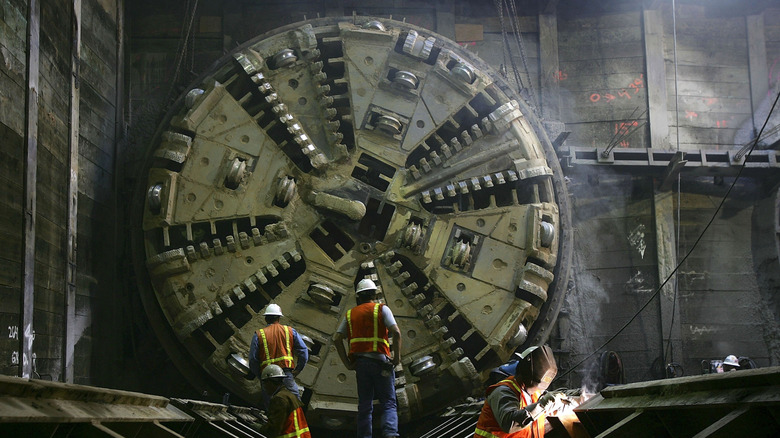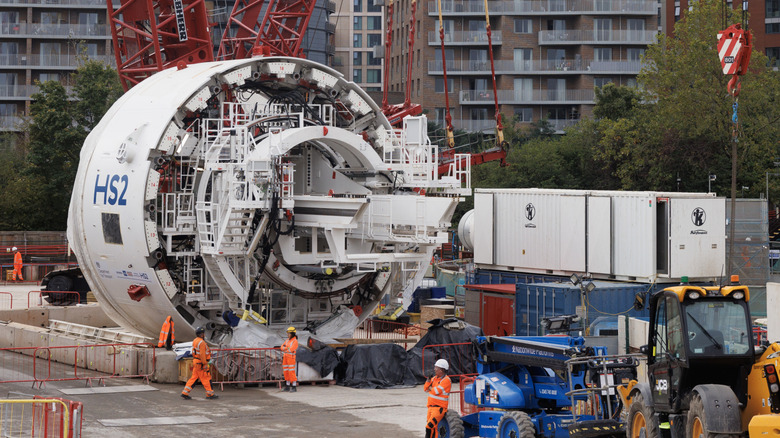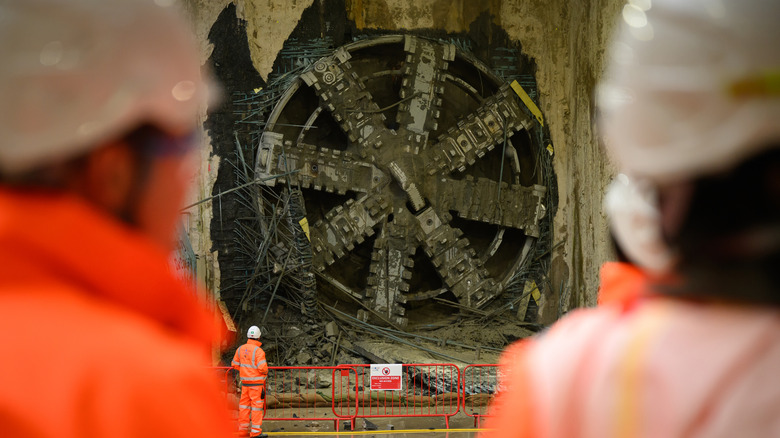Here's How Tunnel Boring Machines Work (And Why They're Sometimes Buried Underground)
In the early decades of the 19th century, London was facing a major problem. The city had become the world's busiest port, but in order to transport goods from the docks to the heavily-populated regions in Britain's south, it was necessary to carry them across the River Thames. The only way to do this at the time was to cross London Bridge, which consequently turned into a nonstop nightmare of a traffic jam. A bold idea was put forth: to dig a tunnel under the river. The problem was, nobody had ever tunneled under a major waterway before. The traditional method of digging by handheld pickaxe wouldn't work because the workers risked the threat of flooding. Finally, someone found a solution, inspired by, of all things, a worm.
French-born engineer Marc Brunel had been working on contracts for Britain's Royal Navy when he caught sight of something in a piece of driftwood. It was a shipworm (Teredo navalis), which is actually not a worm, but a member of the mollusk phylum. Shipworms eat through wood, which passes through their digestive system and comes out the other end as a residue that lines the walls of the tunnel it chews out. This residue hardens, supporting the tunnel's structure, and Brunel realized that if humans could create a similar support system, it would allow them to burrow through the ground just like the shipworm through wood. With this in mind, Brunel proceeded to invent the world's first tunnel boring machine, revolutionizing urban design forever.
A groundbreaking technology
Brunel's original machine, dubbed a tunneling shield, was an iron framework built to brace the earth as a tunnel was dug through it. As the shield advanced, workers would excavate a small bit of earth and fill the space with bricks, repeating this until the whole tunnel had been dug and lined. It wasn't the fastest system — it took 18 years to complete the tunnel — but it set the precedent for a revolutionary technology: tunnel boring machines, or TBMs.
Modern TBMs are far more efficient than Brunel's design, digging up to 50 feet per day. Each TBM has a rotating cutter head at the front that eats through the earth. As it goes, the excavated dirt gets transported away by pipes and conveyor belts, leaving the tunnel clear. At the back end of the TBM, prefabricated tunnel wall segments are inserted, which the machine lays down in the space it excavates. It's the same basic idea as lining the tunnel with brick as you dig, only a whole lot more efficient.
TBMs are not fully-automated, and workers actually ride along inside them, manning the controls. All this work takes a massive machine. When the city of Seattle decided to replace its waterfront viaduct with a tunnel, they used a TBM dubbed "Bertha," that weighed 6,700 tons and was 57.5 feet in diameter (find out how to calculate that to square feet). As you can imagine, disposing of such a behemoth after its job is finished poses a major challenge.
The problem with decommissioning TBMs
Once a tunnel boring project is complete, the TBM is decommissioned, but getting it out of the ground is even more challenging than getting it in. You can't just flip the thing into reverse and back out, so the TBM needs to be disassembled and removed from the tunnel in segments. The cutter head poses the biggest challenge because it is too big to remove in one piece. Workers have to cut it up like a pizza and remove it slice by slice. The casing that surrounds the TBM, known as the skin, cannot be removed at all, or it would compromise the tunnel's stability. Instead, the skin is lined with concrete, turning it into part of the tunnel wall.
Due to the fact that neither the skin nor the cutter head can be removed from a tunnel intact, each TBM can only be used once. The disabled pieces can be sold for the purpose of recycling metal, but some companies have decided that it's more cost effective to simply park the machine underground and leave it there. That's exactly what happened in 2011, with a 200-ton, 22-foot TBM used to excavate train tunnels under New York's Grand Central Terminal. The machine cost around $6–8 million to build, but dismantling and removing it was projected to cost as much as $9 million, so they just left it underground. If you ever walk along Park Avenue between 37th and 38th streets, it'll be right beneath your feet.


